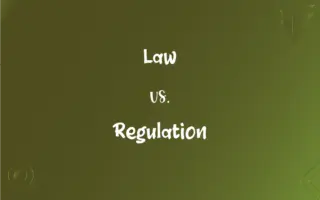Canyon vs. Valley: What's the Difference?
Edited by Harlon Moss || By Janet White || Published on November 16, 2023
Canyon is a deep, narrow chasm with steep walls formed by river erosion; Valley is a broad, low area between hills or mountains.

Key Differences
A canyon is a deep, narrow landform characterized by steep walls, typically created as a result of the erosional force of a river over millions of years. A valley, on the other hand, is a more generic term referring to a depression or low point between two areas of higher elevation, often with a river flowing through it.
Canyons tend to have a more dramatic appearance because of their sharp, steep walls. They can often be found in arid or semi-arid regions where water cuts swiftly through rock layers. Valleys can vary widely in terms of size and depth and are common landforms found in various parts of the world, often shaped by glacial or fluvial processes.
The terms canyon and valley can sometimes be used interchangeably, especially in regions where the distinction between the two is not clear-cut. However, one distinguishing feature is the narrowness and depth of canyons compared to the wider expanse of valleys.
A canyon might be seen as a specialized type of valley with specific formation processes, often linked to river erosion in certain geographical settings. A valley, however, is a broader concept encompassing various types and shapes of depressions in the Earth's surface.
Comparison Chart
Formation
Often formed by river erosion
Formed by glaciers, rivers, or tectonic movements
ADVERTISEMENT
Width
Generally narrow
Can be wide or narrow
Depth
Usually deep with steep walls
Depth varies, can be shallow or deep
Location
Common in arid regions
Found worldwide
Terminology
Specialized type of valley
Broad term encompassing various depressions
Canyon and Valley Definitions
Canyon
A deep, narrow chasm with steep sides, typically carved by river erosion.
The Grand Canyon is one of the most famous canyons in the world.
ADVERTISEMENT
Valley
A natural depression extending from the side of a hill or mountain, drained by a river or stream.
The lush valley was teeming with wildlife, nourished by the meandering river.
Canyon
A landform resulting from the erosive action of flowing water on rock.
The canyon's depths reveal the layers of sediment deposited over eons.
Valley
A depression or hollow resembling or suggesting a valley, as the point at which something divides or branches.
The valley in the folded paper helped him create an origami bird.
Canyon
A pronounced gap or depression in a landscape, usually with a river flowing through.
Hikers love exploring the beauty of the Zion Canyon in Utah.
Valley
A broad stretch of terrain characterized by a downward or concave form.
From the mountain's peak, they could see multiple valleys spreading out below.
Canyon
A significant indentation or cleft in a terrain, notable for its depth.
The sun began to set, casting a golden hue over the canyon walls.
Valley
An elongated trough-like depression that can be glacially formed or created by river erosion.
The valley's fertile soil made it perfect for cultivating crops.
Canyon
A gorge or ravine between cliffs often formed by a river.
The Colorado River carved the vast canyon over millions of years.
Valley
An elongated lowland between ranges of mountains, hills, or other uplands, often having a river or stream running along the bottom.
Canyon
A narrow chasm with steep cliff walls, cut into the earth by running water; a gorge.
Valley
An extensive area of land drained or irrigated by a river system.
Canyon
A valley, especially a long, narrow, steep valley, cut in rock by a river.
Valley
A depression or hollow resembling or suggesting a valley, as the point at which the two slopes of a roof meet.
Canyon
The English form of the Spanish word Cañon.
Valley
An elongated depression cast between hills or mountains, often garnished with a river flowing through it.
Canyon
A ravine formed by a river in an area with little rainfall
Valley
An area which drains itself into a river.
Valley
Any structure resembling one, e.g. the interior angle formed by the intersection of two sloping roof planes.
Valley
To form the shape of a valley.
Valley
The space inclosed between ranges of hills or mountains; the strip of land at the bottom of the depressions intersecting a country, including usually the bed of a stream, with frequently broad alluvial plains on one or both sides of the stream. Also used figuratively.
The valley of the shadow of death.
Sweet interchangeOf hill and valley, rivers, woods, and plains.
Valley
The place of meeting of two slopes of a roof, which have their plates running in different directions, and form on the plan a reëntrant angle.
Valley
A long depression in the surface of the land that usually contains a river
Valley
A low area of land between hills or mountains, often with a river running through it.
The valley stretched out before them, covered in a patchwork of farms and fields.
FAQs
What is a canyon?
A canyon is a deep, narrow chasm with steep walls, often formed by river erosion.
Are all canyons valleys?
Yes, all canyons are specialized types of valleys, but not all valleys are canyons.
Where can you typically find canyons?
Canyons are often found in arid or semi-arid regions where water cuts swiftly through rock layers.
How does a valley differ from a canyon?
A valley is a broad, low area between hills or mountains, while a canyon is a deep, narrow chasm with steep walls.
Which is deeper, a canyon or a valley?
Canyons are typically deeper with steeper walls, while valleys can vary in depth.
Which is wider, a canyon or a valley?
Valleys can be wide or narrow, while canyons are generally narrow.
What causes the formation of a canyon?
Canyons are often formed due to the erosional force of a river over a long period.
Are valleys found only in mountainous regions?
No, valleys can be found in various landscapes, not just mountainous regions.
Can valleys be formed by glaciers?
Yes, valleys can be formed by glaciers, rivers, or tectonic movements.
Are the terms canyon and valley interchangeable?
Sometimes they can be used interchangeably, but they have distinct characteristics.
Which is more prone to flooding, a canyon or a valley?
Both can experience flooding, but valleys, due to their broader expanses, are more commonly associated with floods.
Can canyons be found underwater?
Yes, there are underwater canyons, often formed by turbidity currents in the deep sea.
Which is more common, canyons or valleys?
Valleys are more common as they are broad landforms found in various parts of the world.
How does a river contribute to the formation of a canyon?
Over time, a river can erode the bedrock, creating deep, steep-walled chasms known as canyons.
Can humans create canyons?
While humans can influence landscapes, natural canyons are formed over millions of years by natural processes.
How long does it take for a canyon to form?
The formation of a canyon can take millions of years, depending on environmental conditions.
Are valleys always flat?
No, the floor of a valley can be undulating or even contain smaller hills.
Can a canyon exist without a river?
While rivers often play a significant role in forming canyons, some canyons might not have active rivers within them.
Why are some valleys fertile?
Many valleys accumulate rich sediments carried by rivers, making them fertile for agriculture.
Can valleys have lakes?
Yes, valleys can have lakes, especially if they are formed by glacial activity.
About Author
Written by
Janet WhiteJanet White has been an esteemed writer and blogger for Difference Wiki. Holding a Master's degree in Science and Medical Journalism from the prestigious Boston University, she has consistently demonstrated her expertise and passion for her field. When she's not immersed in her work, Janet relishes her time exercising, delving into a good book, and cherishing moments with friends and family.
Edited by
Harlon MossHarlon is a seasoned quality moderator and accomplished content writer for Difference Wiki. An alumnus of the prestigious University of California, he earned his degree in Computer Science. Leveraging his academic background, Harlon brings a meticulous and informed perspective to his work, ensuring content accuracy and excellence.






































































